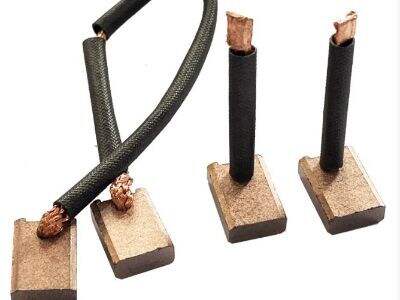ফ্যাক্টরিরা অনেক ধরনের এবং আকারের হতে পারে। ফ্যাক্টরির আকার ছোট থেকে বড় এবং বিশাল পর্যন্ত পরিবর্তিত হতে পারে। কখনও-কখনও চিন্তা করেছেন কি, কেন কিছু ফ্যাক্টরি ছোট? এই লেখায় আমরা ফ্যাক্টরির আকারের বিষয়ে আলোচনা করব। আমরা আলোচনা করব যে কোনো ফ্যাক্টরির কাজের ধরন এবং অবস্থান কিভাবে তার আকারের উপর প্রভাব ফেলতে পারে। এটি আলোচনা করবে ভিন্ন আকারের ফ্যাক্টরির সুবিধা এবং অসুবিধা। শেষ কিন্তু সবচেয়ে গুরুত্বপূর্ণ, আমরা আলোচনা করব যখন প্রযুক্তি বিকাশ করতে থাকে তখন ফ্যাক্টরির ভবিষ্যদ্বাণী কি হতে পারে। আশা করি আপনি ভিন্ন ধরনের ফ্যাক্টরি এবং তাদের বিশেষত্ব উপভোগ করবেন!
ফ্যাক্টরির আকারে পরিবর্তনের কারণ
একটি কারখানার আকার নির্ধারণে বহুমুখী উপাদান সহায়তা করে। কারখানাটি যে পণ্য উৎপাদন করে তা একটি মূল কারণ। এই বিষয়ে তুলনা করলে, কিছু পণ্য - ইলেকট্রনিক্স, যেমন গাড়ি - তাদের নির্মাণ ও জোড়ার জন্য বড় জায়গা দরকার। অনেক সময় এই পণ্যগুলি নির্মাণের জন্য বহুমুখী অংশ থাকে, যা বড় যন্ত্রপাতি যেমন DL রাখার জন্য জায়গা দরকার। গ্রাইন্ডার মেশিন কার্বন ব্রাশ অন্যদিকে, কিছু পণ্য, যেমন চামড়া বা খেলনা, তাদের নির্মাণ সহজ হওয়ায় কম জায়গা লাগতে পারে। এই পণ্যগুলি বড় আদেশ বিনিয়োগ বা জটিল প্রক্রিয়া দরকার নেই, তাই তা তুলনামূলকভাবে ছোট জমির কারখানায় উৎপাদিত হতে পারে।
আরেকটি গুরুত্বপূর্ণ উপাদান যা কারখানার আকার নির্ধারণ করে, তা হল পণ্যসমূহ তৈরি করতে প্রয়োজনীয় কর্মচারীদের সংখ্যা। একটি গাড়ির কারখানায় অনেক শ্রমিক থাকে যারা যানবাহন তৈরি করতে সাহায্য করে, ফলে সকলকে স্থান দেওয়ার জন্য এটি অনেক বড় হতে হয়। অন্যদিকে, পোশাক উৎপাদনের ইউনিট অল্প শ্রমিক প্রয়োজন, সুতরাং এটি আকারে তুলনামূলকভাবে ছোট হতে পারে।
খরচ হল আরেকটি উপাদান যা কারখানার আকার নির্ধারণ করতে পারে। কারখানা যত বড়, তার চালনায় প্রায়শই বেশি টাকা লাগে, তাই এই খরচ দিয়ে পণ্য তৈরি করতে হলে অনেক পণ্য উৎপাদন করতে হবে। বড় কারখানাগুলোতে বেশি খরচ হয়, যেমন বেশি কর্মচারী, বিদ্যুৎ ও জলসরবরাহ, এবং ভবনের রক্ষণাবেক্ষণ। ছোট কারখানাগুলোতে পণ্য তৈরি করতে খরচ কম হতে পারে, কিন্তু এই সুবিধাগুলো সবসময় তাদের বড় প্রতিদ্বন্দ্বীদের মতো পণ্য ম্যাস প্রোডিউস করতে সক্ষম নয়।
কৃষি এবং অবস্থানের উপর ভিত্তি করে কারখানার আকার ভিন্ন হওয়ার কারণ
একটি কারখানার কতটুকু বড় হওয়া উচিত তা বিশেষ ভাবে শিল্পের ধরনের উপর নির্ভর করে। উদাহরণস্বরূপ, ভারী যন্ত্রপাতি তৈরি করে যে কারখানাগুলো... রেডিয়েটর ফ্যান মোটর কার্বন ব্রাশ অথবা গাড়ির জন্য বড় এলাকা এবং সম্পদ-ভারি হয়। তাদের পণ্যগুলি চালাতে বড় কার্যালয়ের প্রয়োজন ছাড়াও তাদের চালু করার জন্য প্রয়োজনীয় বিশেষ উপকরণের প্রয়োজন হয়। তবে, ছোট আইটেমের কারখানাগুলি যেহেতু তাদের দ্বারা তৈরি পণ্যগুলি কম জায়গা নেয়, সাধারণত তারা বেশি ঘনিষ্ঠ এলাকায় কাজ করতে সক্ষম হয়।
লাভজনক কারখানা অবস্থান: সাইটটিও আপনার মৌলিক উপাদান। শহরের ব্যস্ত অংশে অবস্থিত কারখানাগুলি মহাগঠনীয় জমির কারণে এবং কম জায়গা থাকায় সংকুচিত হতে পারে। শহুরে পরিবেশে, কারখানাগুলি জমির আকারে সীমাবদ্ধ হয় কারণ তারা যা পায় তার সাথে কাজ করতে হয়। শহরের বাইরে অবস্থিত কারখানাগুলি কারখানা হিসেবে সস্তা এবং সাধারণত বড় খোলা বা অব্যবহৃত জমি থাকে যা বড় কারখানা স্থাপনের জন্য উপযুক্ত। তারা বেশি জায়গা পেয়ে তৈরি এবং বৃদ্ধি করতে পারে যা অর্থ তারা বেশি পণ্য উৎপাদনের ক্ষমতা রাখে।
বিভিন্ন ধরনের কারখানার সুবিধা এবং অসুবিধা
অন্যান্য কারখানা আকারও সুবিধা ও অসুবিধা নিয়ে আসে। এখানে চালু খরচ কম থাকা একটি বড় পজিটিভ ফ্যাক্টর, এবং ছোট কারখানাগুলোতে এটি সাধারণত সত্য। এটি তাদের অনেক কর্মচারী ও জায়গা রক্ষণাবেক্ষণের দরকার না হওয়ায় টাকা বাঁচায়। কিন্তু বড় সংখ্যার উৎপাদনের ক্ষেত্রে তারা বড় কারখানাগুলোর সাথে প্রতিযোগিতা করতে পারে না। বৃহত্তম কারখানাগুলো কম সময়ে বেশ কিছু পণ্য উৎপাদন করতে পারে, যা তাদের বাজারে প্রতিযোগিতামূলক সুবিধা দেয়।
যদিও বড় কারখানা চালু খরচে বেশি খরচ করে, তবে সাধারণত তারা অনেক তাড়াতাড়ি পণ্য উৎপাদন করে, উদাহরণস্বরূপ, ডায়াল মশিনের মোটরের জন্য কার্বন ব্রাশ . এবং অনেক ক্ষেত্রেই তারা তাড়াতাড়ি এবং উন্নত যন্ত্রপাতি এবং সিস্টেম ব্যবহার করে। এই গতি তাদের আরও বেশি পণ্য বিক্রি করতে এবং শিল্পের অন্যান্য প্লেয়ারদের সাথে প্রতিযোগিতা করতে সাহায্য করে। কিন্তু এই বড় কারখানাগুলোকেও তাদের খরচ সামঞ্জস্য করতে হয় যেন তারা লাভজনক থাকে।
কেন কারখানার আকার শৈলী এবং দক্ষতা দ্বারা প্রভাবিত
বিভিন্ন কারখানা শ্রমিকদের অভিজ্ঞতা এবং দক্ষতা এবং কারখানা চালু থাকার উপায়ের উপর ভিত্তি করে আকারে ভিন্ন। একটি নির্দিষ্ট কিন্তু সংকীর্ণ পণ্য-অথবা-প্রযুক্তি ফোকাস বিশিষ্ট কারখানাকে ঐ পণ্যের মাগ পূরণ করতে হলে বড় সংখ্যক শ্রমিক এবং বড় জমি প্রয়োজন হতে পারে। অন্য একটি কারণ হতে পারে যে, এটি মানসম্পন্ন ইলেকট্রনিক ডিভাইস তৈরি করে এমন একটি কারখানা যা ভাল মানের জন্য পরিচিত এবং তাদের সবকিছু ঠিকঠাক করতে আরও বেশি কর্মচারীর প্রয়োজন হয়।
একটি বহুমুখী পণ্য উৎপাদনকারী কারখানাকে অনেক শ্রমিকের প্রয়োজন হতে পারে না, এছাড়াও কম জায়গা প্রয়োজন হতে পারে। বিভিন্ন ম্যানেজমেন্ট শৈলীও কারখানার আকারের উপর প্রভাব ফেলে। মান এর উপর মাত্রা চাওয়া একজন ম্যানেজার ১০০ জনের বদলে ১০ জনের একটি কারখানা চালু রাখতে চাইতে পারে। এটি তাদেরকে প্রতিটি পণ্যের উপর তাদের প্রয়াস ফোকাস করতে এবং তা উচ্চমানের নিশ্চিত করতে দেয়।
কারখানা আকারের ভবিষ্যত
কিন্তু প্রযুক্তি এবং আয়ের অর্থনৈতিক স্কেল জিনিসপত্র তৈরি হওয়ার উপায় পরিবর্তন করছে, ফলে ফ্যাক্টরির আকারও পরিবর্তনশীল হতে হবে। ইউনিট এবং অন্যান্য নতুন উন্নয়ন যেমন রোবটিক্স ছোট ফ্যাক্টরিগুলোকে দ্রুত পণ্য তৈরি করতে সক্ষম করতে পারে, এটি বড় ফ্যাক্টরিগুলোর সঙ্গে প্রতিযোগিতা করার একটি সুযোগ দেয়। তারা মনে করেন ছোট ফ্যাক্টরিগুলো তাদের উৎপাদনে বেশি কার্যকর এবং কার্যক্ষমতা বাড়াতে পারে। একই সাথে, বড় ফ্যাক্টরিগুলো আরও বড় হবে এবং তাদের আকারের সুযোগ ব্যবহার করবে, যাতে ব্যাচে পণ্য তৈরি করা সস্তা হয়।
অনুরূপভাবে, স্থিতিশীলতা এবং পরিবেশ রক্ষার দিকে আগ্রহ বাড়ছে। এটি ছোট, সবজ ফ্যাক্টরি তৈরির দিকে প্রভাব ফেলতে পারে যা কম শক্তি খরচ করে এবং কম অপশিষ্ট উৎপাদন করে। এই ছোট ফ্যাক্টরিগুলো গ্রিন পণ্য তৈরি করতে পারে যা পৃথিবীর জন্য ভালো।
অবশেষে, একটি কারখানার আকার অনেকগুলি চলতিপরিবর্তনশীলের উপর নির্ভর করে, যাতে কি পণ্য উৎপাদিত হচ্ছে, শ্রমের প্রয়োজন এবং চালু রাখার জন্য কত খরচ লাগে। কারখানার আকারকে প্রভাবিত করে আরেকটি গুরুত্বপূর্ণ উপাদান হল শিল্প এবং তার অবস্থান। প্রতিটি কারখানার আকারের নিজস্ব সেট চ্যালেঞ্জ এবং সুবিধা রয়েছে, এবং আপনি কিভাবে একটি কারখানা চালান তা বেশিরভাগই তার আকারের উপর নির্ভর করে। প্রযুক্তির উন্নয়নের সাথে, ভবিষ্যতে কারখানাগুলি এত বড় হতে পারে না, তাই আমরা পরিবর্তনশীল ট্রেন্ডের উপর নজর রাখতে চাই যাতে আমাদের গ্রাহকদের জন্য ভালো পণ্য আনা যায়।

 BN
BN
 EN
EN
 AR
AR
 FR
FR
 DE
DE
 IT
IT
 PL
PL
 PT
PT
 RU
RU
 ES
ES
 ID
ID
 UK
UK
 VI
VI
 TH
TH
 TR
TR
 FA
FA
 MS
MS

